How can I make my fireplace more efficient?
Try adding one of the many accessories available that make fireplaces more efficient, including tube grates, heat extractors and glass... More »
Throughout the ages, the fireplace has been considered the heart of the home. It’s symbolizes warmth and sustenance, and from a design perspective, it’s usually the focal point of the home. With the advent of flat screen TVs, the fireplace continues to be a focal point where families gather to watch their favorite movies and television shows. Since it’s still such a favorite spot, why not give it a makeover to bring back some design flair?
Throughout the ages, the fireplace has been considered the heart of the home. It’s symbolizes warmth and sustenance, and from a design perspective, it’s usually the focal point of the home. With the advent of flat screen TVs, the fireplace continues to be a focal point where families gather to watch their favorite movies and television shows. Since it’s still such a favorite spot, why not give it a makeover to bring back some design flair? Stay tuned, because that’s exactly what we’re going to do in this episode.
Today we’re going to use paint to transform our fireplace. First, we’ll prep and paint the fireplace cover with spray paint designed to withstand high temperatures. Then, we’ll repaint the brick and the mantel to give it more of a clean, contrasting, updated look. So let’s get started.
As with any painting project, the first thing we need to do is thoroughly prep the surfaces that we’ll be painting. For this project, we’ll be dealing with three different surfaces, including wood, brick and metal. And all three need to be cleaned before we paint. We’ll start by spreading a drop cloth and mixing some Tri Sodium Phosphate into a bucket of warm water, following the manufacturer’s instructions carefully. Always wear gloves with working with TSP. With a sponge, we’ll wipe the mantle surface down and dry it thoroughly.
Next, we’ll remove the fireplace doors by removing the bracket assembly that clamps the unit to the firebox. It basically just unscrews. We’ll take it out in the garage and place it on a pair of sawhorses for now.
Back inside, we’re going to mask off the slate tile and clean any visible soot off the brick to get it ready for priming. Our fireplace bricks actually look pretty clean ... just a few areas to address. This scrub brush and some white vinegar will take care of that.
Priming the brick will help stretch our paint further, as brick’s porous surface is notorious for soaking up a lot of paint. To prime the brick, we could use a roller cover with a 3/4" nap to speed the process along. However, we’re going to skip the roller and take our time using this brush, since we’d need it to paint all the grout lines anyway.
Now we’ll head back out to the garage and prep the glass doors for a coat of paint. To prep the fireplace doors, we’ll give it a light sanding with this fine-grit sanding sponge. This will help the paint adhere to the metal surface. We’ll use denatured alcohol to clean it and dry it with these shop rags. Then we’ll carefully mask the glass doors with painter’s tape and newspaper, making sure that none of the glass is exposed. Now the surface is properly prepared for spray painting.
When using spray paint, always make sure you wear safety glasses and a respirator to avoid inhaling paint fumes. Also, make sure the work area is well-ventilated.
Since this is a traditional, wood-burning fireplace, the spray paint we’ll be using is high-heat spray paint designed to withstand temperatures up to 1,200-degrees Ferenheit. We chose black to match the color of our slate tile. It will also mimic the look of our TV.
With spray paint, achieving a quality finish requires using the proper spraying technique. To help, we’ll be using a gun-style applicator accessory that will reduce fatigue. First shake the can vigorously for 60 seconds. Then, insert the can into the gun according to the manufacturer’s instructions. It’s a good idea to practice spraying on some old cardboard to get your technique down before spraying the actual piece. We’ll hold the tip of the can about 8 or 10" away from the surface to be painted and spray in a back and forth motion, slightly overlapping our lines. Remember, whenever you start spraying, make sure the can is in motion to prevent getting too much paint in one area. Here is the correct way to start a strip. Here is the incorrect way. See how the paint globs and starts to run when the can is not in motion. Also, make sure you hold the can the same distance from the work surface to avoid inconsistent coverage. That’s what we’re looking for. Now we’ll try it on our fireplace doors.
When we’ve finished giving it the first light coat, we’ll give it 15 minutes or so to dry and repeat the process. This might take three or four light coats to properly cover the piece. But several lighter coats will adhere better and look nicer than one thick coat. After applying the last coat, we’ll give it a good 24 hours to cure before reinstalling the unit back in the fireplace.
While our fireplace doors are drying, we’ll head back inside and paint the mantle. We’re going to start with the top and paint it black to match the look of our slate. After masking it, we’ll cut in using our angled sash brush and finish with this mini-roller. Then we’ll paint the rest of the mantle using the same white paint that we used on the brick. Even though we’re using the same shade of white, the difference in texture between the brick and the wooden mantle will provide just enough color contrast to add even more visual interest. Now that all of our surfaces are completely dry, we’ll reinstall the doors and remove the masking tape. The last thing to do is clean the glass with glass cleaner, and clean the slate with this tile cleaner. What a dramatic difference ... all from a couple cans of paint.
So there you have it. Now we’ll sit back, pop some popcorn and put on our favorite show. The hard part will be keeping our attention on the program and not get distracted admiring the new look of our fireplace makeover.
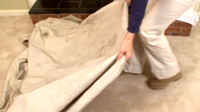
Spread out a drop cloth around the fireplace.
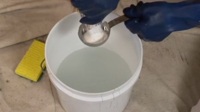
Prep all surfaces for paint. Mix Trisodium phosphate with warm water in a bucket.
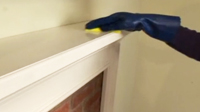
Using a sponge, wipe down and dry the mantle.
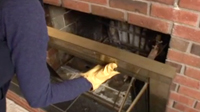
Remove the fireplace doors and scrub all soot off brick and stone with white vinegar.
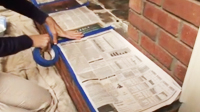
Cover horizontal surfaces of the fireplace where the drop cloth doesn't reach.
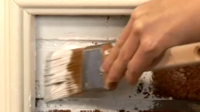
Prime areas of stone or brick.
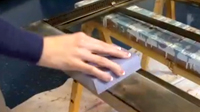
Lightly sand metal surfaces and clean with denatured alcohol.
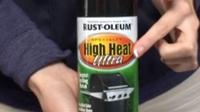
Use a high heat spray paint to spray on metal.
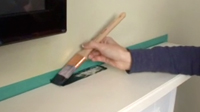
Paint the rest of the surfaces with a paint brush and/or roller. Let everything dry overnight before reassembling the pieces.
Try adding one of the many accessories available that make fireplaces more efficient, including tube grates, heat extractors and glass... More »
Clean chimneys once a year and inspect them twice a month. This is usually best performed by a professional chimney sweep. A clean metal chimney... More »
A heat extractor mounts on the stovepipe and extracts additional heat from flue gases beyond what normally comes from the stovepipe or the chimney.... More »
If you need to touch up the paint on the non-porcelain surfaces of your grill, such as the endcaps or the cook box, use a high heat-resistant... More »
Silicone caulks are water resistant and provide excellent adhesion to smooth surfaces, such as metal, glass and tile. However, it does... More »
A tube grate functions like a conventional grate or andiron in a fireplace. It is an energy saving device that pulls air into the bottom tube... More »
For many paints, a gallon will cover 400 square feet. However, the quality of the paint can affect how much it will cover. The label on... More »
You can paint aluminum siding. Be sure to prep it properly by sanding with a fine-grit paper and clean it. Replace dented siding or repair with... More »
Yes, just as you would with a paint brush. Natural fiber roller covers made with mohair or a blend of polyester and lamb’s wool are... More »
Using a fine steel wool between multiple coats will give you a smoother surface. Be sure to clean the surface with a tack cloth before... More »
Do you want to change the look and style of a particular room in your home? Why not give it a fresh coat of paint? It can make a big difference for... More »
Painting the ceiling can give a room a fresh look. And it’s the perfect place to start when your project calls for repainting an entire room. In... More »
Your newly painted walls look great! But you’re not finished yet. Watch this video and learn how to clean up after your paint project so that your... More »
There’s perhaps no better and more affordable way to add interest to your home’s exterior than by giving it a fresh new coat of paint. Whether... More »
Without proper maintenance, a wooden deck won’t last long. To protect your deck and keep it looking like new, you need to refinish it and give it... More »
In this first episode in our 2-part series on refinishing an antique, we’ll show you how to remove the existing finish and get it ready for... More »
You’ve decided what color your going to repaint your house and trim and you’re ready to get started. But wait. Don’t forget to prep the siding... More »
To get the best results when painting, you need to spend time before you start properly prepping the room and the walls. It makes all the... More »
Today we’re going to fix the crumbling mortar in this brick siding using a process called repointing. Be sure to wear leather glovers and safety... More »
Now that you’ve prepped the floor, patched the holes and filled the cracks, it’s time to add that epoxy finish. In part two of this two-part... More »
An asphalt driveway can take quite a beating from the elements. Before your driveway is too far gone, take some time to fill the cracks and add a... More »
No matter how big or small it is, a hole in the wall is an unsightly blemish that won’t go away by itself. Watch this video to learn how to fix... More »